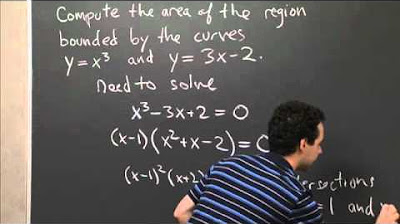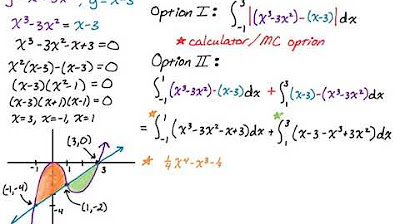Area between curves with multiple boundaries
TLDRThe video script outlines a method for calculating the area of a shaded region by dividing it into two parts and using definite integrals. The first part involves integrating from x=0 to x=1 with the upper function as the square root of x and the lower function as x squared over 4 minus 1. The second part integrates from x=1 to x=2 with the upper function as 2 minus x and the lower function remaining the same. By finding the antiderivatives, evaluating them at the appropriate bounds, and summing the results, the total area is determined to be 2 and 1/2 square units.
Takeaways
- 📚 The video demonstrates how to find the area of a region shaded in yellow, divided into two distinct sections.
- 🔬 The lower boundary of the region is defined by the function y = x^2 / 4 - 1.
- 📍 The upper boundaries vary between the two sections: the first uses y = sqrt(x), and the second uses y = 2 - x.
- 🔢 The method involves calculating definite integrals for each section, from x = 0 to x = 1 for the first, and x = 1 to x = 2 for the second.
- 📝 Simplification and calculation of these integrals require subtraction of the lower function from the upper function for both regions.
- 💾 The antiderivatives are found for the integrands, simplifying the process of finding the area under each curve.
- 🔧 Evaluation at the boundaries for each integral provides the areas for the individual sections.
- 📱 The results from each section are added together to get the total area of the shaded region.
- ✏️ Arithmetic simplification leads to the combined area being expressed as a fraction, which is then simplified to a decimal.
- 🏆 The final outcome of the calculation reveals that the total area of the specified region is 2 and 1/2 square units.
Q & A
What is the main objective of the video?
-The main objective of the video is to find the area of a region shaded in yellow, which is defined by a lower function y = x^2/4 - 1 and varying upper functions.
How is the region divided to tackle the problem?
-The region is divided into two sections or regions for easier calculation: the left region from x=0 to x=1 with the upper function y = sqrt(x), and the right region from x=1 to x=2 with the upper function y = 2 - x.
What is the lower boundary function for the entire region?
-The lower boundary function for the entire region is y = x^2/4 - 1.
What is the upper boundary function for the left region (x=0 to x=1)?
-The upper boundary function for the left region is y = sqrt(x).
What is the upper boundary function for the right region (x=1 to x=2)?
-The upper boundary function for the right region is y = 2 - x.
How does the video approach the calculation of the area?
-The video approaches the calculation by setting up definite integrals for each region, subtracting the lower function from the upper function, and then evaluating the resulting antiderivative at the bounds of each region.
What is the Riemann definition of a definite integral as described in the video?
-The Riemann definition of a definite integral described in the video is the process of summing up an infinite number of ultra-thin rectangles, each with width dx, to approximate the area under a curve as the change in x approaches 0.
How are the antiderivatives of the functions found in the video?
-The antiderivatives are found by applying standard integration rules. For the function x^(1/2), the antiderivative is x^(3/2) * (2/3), and for x^2/4, the antiderivative is x^3/12.
What is the final area of the shaded region?
-The final area of the shaded region is 2 and 1/2 or 5/2.
How does the video ensure clarity in the explanation?
-The video ensures clarity by breaking down the problem into smaller sections, using different colors to distinguish between regions, and providing step-by-step calculations with clear explanations.
What mathematical concepts are used in the video?
-The mathematical concepts used in the video include definite integrals, antiderivative calculation, the Riemann sum, and basic algebraic manipulation for simplifying expressions.
Outlines
📊 Calculating the Area of a Shaded Region
The paragraph discusses the process of finding the area of a region divided by a curve, with the lower boundary defined as y = x^2/4 - 1 and varying upper boundaries. The strategy involves dividing the region into two parts: the left region with the upper boundary as the square root of x from x=0 to x=1, and the right region with the upper boundary as 2-x from x=1 to x=2. The area is found by calculating the definite integrals for each region and summing them up, using the Riemann definition of a definite integral as the limit of the sum of infinitesimally thin rectangles.
📈 Evaluating Integrals to Find the Total Area
This paragraph details the evaluation of the definite integrals for both regions described in the previous paragraph. The left region's integral is simplified to ∫(from 0 to 1) of (sqrt(x) - (x^2/4 + 1)dx), and the right region's integral is ∫(from 1 to 2) of (2 - x - (x^2/4 + 1)dx). The antiderivatives are calculated, and the integrals are evaluated at the respective bounds. The final step involves adding the results of both integrals to find the total area of the shaded region, which is determined to be 2 and 1/2.
Mindmap
Keywords
💡Area
💡Lower Function
💡Upper Function
💡Definite Integral
💡Antiderivative
💡Interval
💡Riemann Sum
💡Intersection
💡Subtract
💡Evaluate
💡Simplify
Highlights
Introduction to finding the area of a complex region shaded in yellow.
The region's lower boundary is defined by the function y = x^2 / 4 - 1.
Division of the region into two sections for simplification.
Identification of the intersection point at (1,1) between the two functions.
The upper function for the left region is y = sqrt(x).
For the right section, the upper function changes to y = 2 - x.
Introduction to the definite integral approach for area calculation.
Setting up the definite integral for the left region from x=0 to x=1.
Setting up the definite integral for the right region from x=1 to x=2.
Simplification of the integral expressions.
Explanation of the Riemann definition of a definite integral.
Calculation of the antiderivative for the left and right regions.
Evaluation of the definite integrals at their respective bounds.
Combining the results of the left and right regions to find the total area.
Conclusion that the total area of the specified region is 2.5 (or 5/2).
Transcripts
Browse More Related Video

Area between a curve and the x-axis | AP Calculus AB | Khan Academy

Definite integral involving natural log | AP Calculus AB | Khan Academy

Area Between y=x^3 and y=3x-2 | MIT 18.01SC Single Variable Calculus, Fall 2010

Definite Integrals — Topic 88 of Machine Learning Foundations

Area Between Two Curves with Multiple Regions: y = x^3-3x^2 and y = x-3

Calculus - Definite Integrals
5.0 / 5 (0 votes)
Thanks for rating: